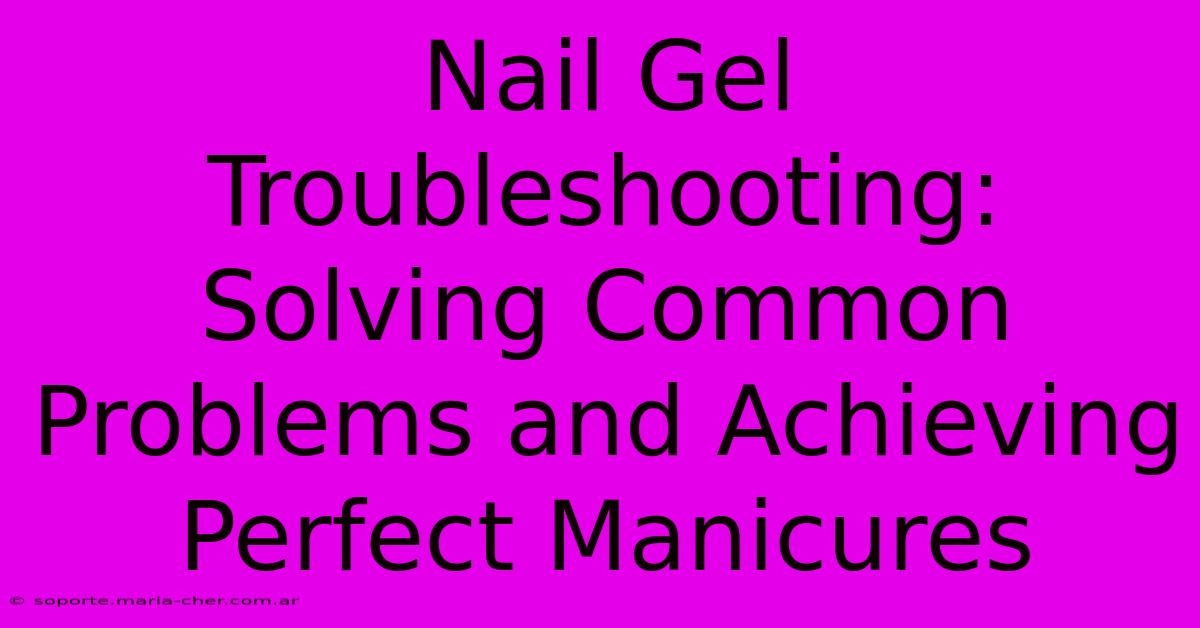Nail Gel Troubleshooting: Solving Common Problems And Achieving Perfect Manicures

Table of Contents
Nail Gel Troubleshooting: Solving Common Problems and Achieving Perfect Manicures
Achieving salon-quality gel manicures at home can be incredibly rewarding, but it's not always smooth sailing. From sticky residue to lifting and chipping, a host of issues can derail your perfect mani. This comprehensive guide tackles common nail gel problems, offering practical solutions to help you troubleshoot and achieve flawless results every time.
Common Nail Gel Problems & Their Solutions
Gel manicures, while long-lasting and beautiful, can present several challenges. Let's dive into the most frequent issues and how to fix them:
1. Sticky Residue After Curing:
This annoying residue is often caused by improper curing or an overly thick layer of top coat.
- Solution: Gently wipe the sticky layer with a lint-free wipe saturated with 99% isopropyl alcohol. Avoid harsh rubbing, as this can damage the gel polish. If the stickiness persists, try increasing your curing time slightly.
2. Lifting and Chipping:
Lifting, where the gel separates from the nail, and chipping are common complaints. Several factors can contribute:
-
Poor Preparation: Insufficient cleaning and prepping of the nail surface is the biggest culprit. Oils and debris prevent proper adhesion.
-
Incorrect Application: Applying too thick coats, leaving air bubbles, or not sealing the edges properly can lead to lifting.
-
Low-Quality Products: Using inferior gels and top coats may not provide the necessary durability.
-
Solutions:
- Thorough Preparation: Ensure your nails are completely clean, dry, and free of oils and dust before application. Use a nail dehydrator and a primer for optimal adhesion.
- Thin Coats: Apply thin, even coats of base coat, color gel, and top coat, allowing each layer to cure completely.
- Proper Curing: Make sure your lamp is working properly and that you're curing each layer for the recommended time.
- Careful Application: Pay close attention to sealing the edges of your nails to prevent lifting.
- High-Quality Products: Invest in reputable brands known for their quality and durability.
3. Uneven Application:
An uneven finish is often due to improper technique or rushing the process.
-
Solutions:
- Practice Makes Perfect: Take your time and practice applying thin, even coats.
- Proper Tool Usage: Use a good quality brush and control your application technique.
- Multiple Thin Coats: Instead of one thick coat, apply several thin coats for a smoother, more even finish.
4. Gel Polish Peeling:
This frustrating problem usually points to inadequate preparation or product incompatibility.
-
Solutions:
- Check for Moisture: Ensure your nails are completely dry before applying gel polish.
- Avoid Over-Filing: Excessive filing weakens the nail plate and contributes to peeling.
- Compatible Products: Use products from the same brand or compatible brands to avoid reactions.
5. Curing Issues:
Problems with curing can stem from faulty lamps, incorrect curing times, or overly thick layers of polish.
-
Solutions:
- Lamp Check: Ensure your UV or LED lamp is working correctly and producing sufficient UV light. Replace bulbs as needed.
- Accurate Timing: Follow the manufacturer's instructions for curing times precisely.
- Thin Coats: Again, thin coats are key to proper curing.
Tips for Perfect Gel Manicures:
- Invest in Quality Products: Using quality gel polishes, base coats, top coats, and tools is essential for long-lasting results.
- Proper Nail Preparation: This step is crucial. Don't skip any stages of the preparation process.
- Patience and Practice: Mastering gel manicures takes time and practice. Don't get discouraged if your first few attempts aren't perfect.
- Regular Maintenance: Even with the best techniques, your gel manicure will eventually need to be removed. Properly removing the gel is vital to protect your natural nails.
By addressing these common problems and following these helpful tips, you can significantly improve the quality and longevity of your at-home gel manicures. Happy polishing!

Thank you for visiting our website wich cover about Nail Gel Troubleshooting: Solving Common Problems And Achieving Perfect Manicures. We hope the information provided has been useful to you. Feel free to contact us if you have any questions or need further assistance. See you next time and dont miss to bookmark.
Featured Posts
-
From Our Honeymoon To Your Hearts A Glimpse Of Our Newlywed Holiday Magic
Feb 09, 2025
-
Say Goodbye To Boring T Shirts Unleash Your Creativity With Printed Images
Feb 09, 2025
-
Canon G Iii Ql Vs Leica M3 The Battle Of Rangefinder Legends
Feb 09, 2025
-
Art On Demand How Strathmore Bristol Board Powers Your Creative Vision
Feb 09, 2025
-
Your Guide To Fotolia Discover The Ultimate Source For Royalty Free Visual Content
Feb 09, 2025
